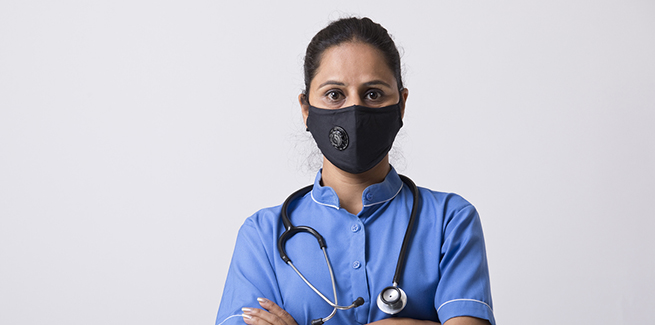The COVID mask you shouldn’t wear

In what may have been a game-changing moment in the fight against the spread of COVID, Walmart took a stand on the mask versus no mask debate on July 15, when it announced that, starting July 20, in-store mask wearing would be mandatory.
Within days, other major retailers including Target, Kroger, and Walgreens followed suit, requiring customers to wear face masks in all of their stores, even in locations without local mask ordinances.
But nobody said what kind of mask should you wear.
That depends on your goal. If it’s to help stop the spread of COVID, don’t wear one with an exhalation valve.
They look higher tech than plain cloth masks, so you might assumed they offer more protection. Not so, according to J. Scott Weese, DVM, DVSc, DACVIM, and a contributing reviewer of AAHA’s Infection Control, Prevention, and Biosecurity Guidelines. Weese addressed the topic of face masks in May in a two-part post on his Worms and Germs blog.
He says an exhalation valve makes it easier to breathe out because they’re one-way valves that allow you to release exhaled air without having to force it through a filter. He told NEWStat that’s fine if you’re using the mask to protect yourself—and as long as you’re not infected.
But it’s a problem if you are infected. Because that means you’re exhaling infectious droplets that pass right through that exhalation valve, potentially infecting everyone around you.
Masks with exhalation valves protect the user from other people but they don’t protect other people from the user, Weese told NEWStat. And protecting other people is the “main reason masks are recommended for COVID control outside of healthcare situations.”
So what kind of mask should hospital staff be wearing? Again, Weese says, it depends on your goal.
For general COVID control, Weese says a nonmedical mask is fine: “That can be a cloth mask or a mask that’s basically the same as a surgical mask.” Weese says those masks can’t be sold as surgical masks because they don’t undergo the rigorous testing that surgical masks require. “Surgical masks are fine, too,” he adds, while acknowledging that the messaging for the general public has been to use nonmedical masks to try to prevent shortages of medical masks. “That’s less of a concern now that mask manufacturing has ramped up.”
His bottom line: “Unless you are using an N95 mask during a high-risk healthcare procedure—where the only concern is what you’re inhaling, and not what you’re exhaling—don’t use a mask with a valve.”
The US Centers for Disease Control and Prevention (CDC) back him up. On their Personal Protective Equipment: Questions and Answers webpage (updated July 22), the CDC says: “Respirators with exhalation valves should not be used in situations where a sterile field must be maintained (e.g., during an invasive procedure in an operating or procedure room) because the exhalation valve may allow unfiltered exhaled air to escape into the sterile field.”
As for people who resist wearing masks because they say masks make it harder to breathe (you may have clients among them), Weese says it’s likely that they just don’t want to wear a mask.
“Yes, [masks] can be uncomfortable, but that’s something we have to tolerate,” Weese says. “I tend not to get into it too much with people who don’t want to wear a mask, but one thing I talk about is how we’ve worn masks for prolonged periods of time in human and veterinary healthcare—such as during long surgeries—and [being unable to breathe] hasn’t been an issue. We have lots of surgeons with asthma and other comorbidities, and they wear masks all day.”
Weese adds, “If masks were a reasonable health risk, we’d know.”
Photo credit: © iStock/trilocks



